Principle of Financial Management Report: Continental Clothing Company
VerifiedAdded on 2023/01/10
|21
|5448
|21
Report
AI Summary
This report provides a detailed analysis of financial management principles, using the Continental Clothing Company as a case study. It begins by examining approaches, techniques, and factors that contribute to effective decision-making, including knowledge-based and formal/informal approaches, along with techniques like decision trees and T-charts. The report then explores stakeholder management and the handling of conflicting objectives, emphasizing the importance of communication and relationship building. It also delves into the value of management accounting in cost control and maximizing shareholder value, outlining techniques such as historical cost accounting, budgetary control, standard costing, and funds flow statements. Furthermore, it covers techniques for fraud detection and prevention, highlighting the use of machine learning and ethical decision-making strategies. The second part of the report analyzes financial data to inform operational and strategic decisions, compares investment appraisal techniques, and demonstrates how financial decision-making supports long-term sustainability, concluding with recommendations on how management accountants can improve financial sustainability.
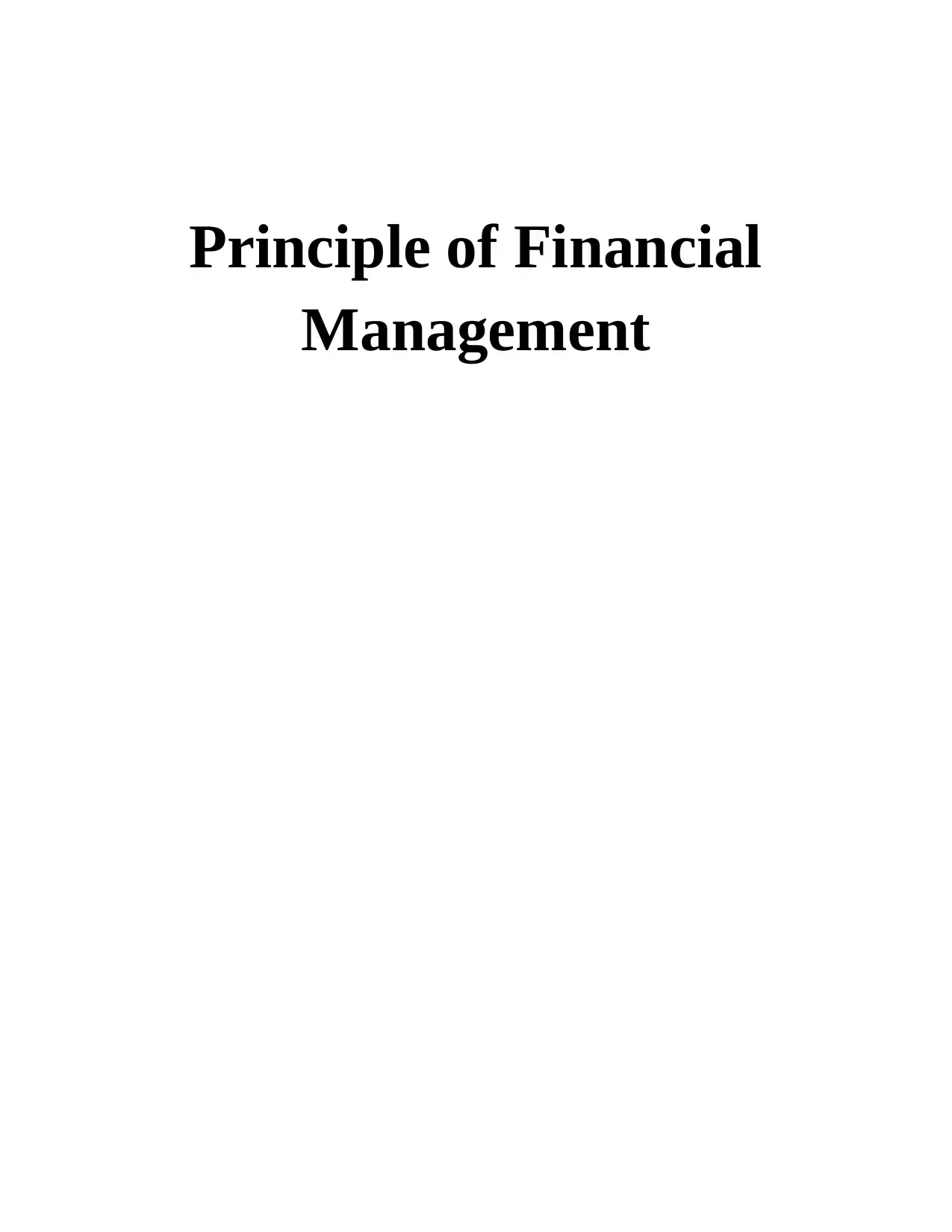
Principle of Financial
Management
Management
Paraphrase This Document
Need a fresh take? Get an instant paraphrase of this document with our AI Paraphraser

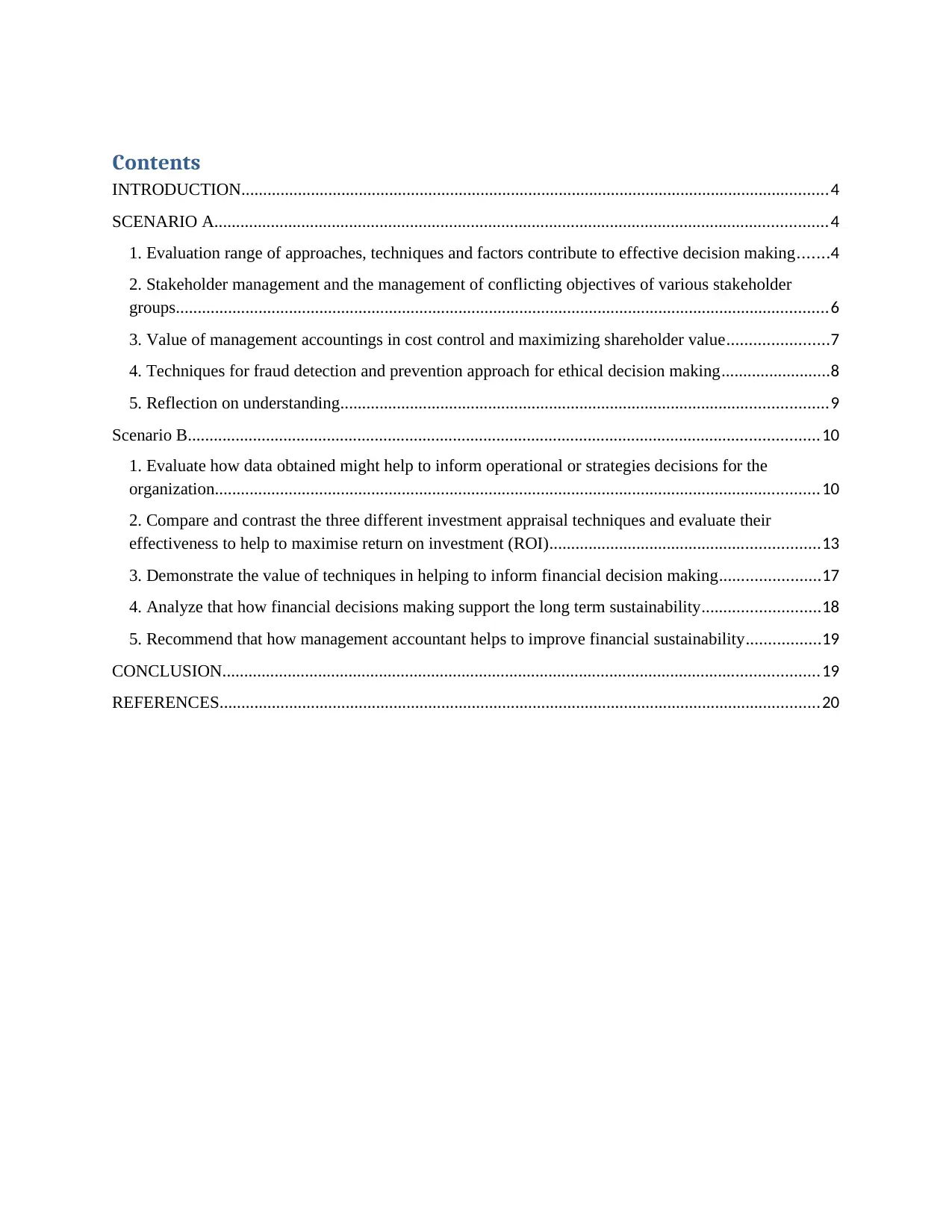
Contents
INTRODUCTION.......................................................................................................................................4
SCENARIO A.............................................................................................................................................4
1. Evaluation range of approaches, techniques and factors contribute to effective decision making.......4
2. Stakeholder management and the management of conflicting objectives of various stakeholder
groups......................................................................................................................................................6
3. Value of management accountings in cost control and maximizing shareholder value.......................7
4. Techniques for fraud detection and prevention approach for ethical decision making.........................8
5. Reflection on understanding................................................................................................................9
Scenario B.................................................................................................................................................10
1. Evaluate how data obtained might help to inform operational or strategies decisions for the
organization...........................................................................................................................................10
2. Compare and contrast the three different investment appraisal techniques and evaluate their
effectiveness to help to maximise return on investment (ROI)..............................................................13
3. Demonstrate the value of techniques in helping to inform financial decision making.......................17
4. Analyze that how financial decisions making support the long term sustainability...........................18
5. Recommend that how management accountant helps to improve financial sustainability.................19
CONCLUSION.........................................................................................................................................19
REFERENCES..........................................................................................................................................20
INTRODUCTION.......................................................................................................................................4
SCENARIO A.............................................................................................................................................4
1. Evaluation range of approaches, techniques and factors contribute to effective decision making.......4
2. Stakeholder management and the management of conflicting objectives of various stakeholder
groups......................................................................................................................................................6
3. Value of management accountings in cost control and maximizing shareholder value.......................7
4. Techniques for fraud detection and prevention approach for ethical decision making.........................8
5. Reflection on understanding................................................................................................................9
Scenario B.................................................................................................................................................10
1. Evaluate how data obtained might help to inform operational or strategies decisions for the
organization...........................................................................................................................................10
2. Compare and contrast the three different investment appraisal techniques and evaluate their
effectiveness to help to maximise return on investment (ROI)..............................................................13
3. Demonstrate the value of techniques in helping to inform financial decision making.......................17
4. Analyze that how financial decisions making support the long term sustainability...........................18
5. Recommend that how management accountant helps to improve financial sustainability.................19
CONCLUSION.........................................................................................................................................19
REFERENCES..........................................................................................................................................20
⊘ This is a preview!⊘
Do you want full access?
Subscribe today to unlock all pages.

Trusted by 1+ million students worldwide
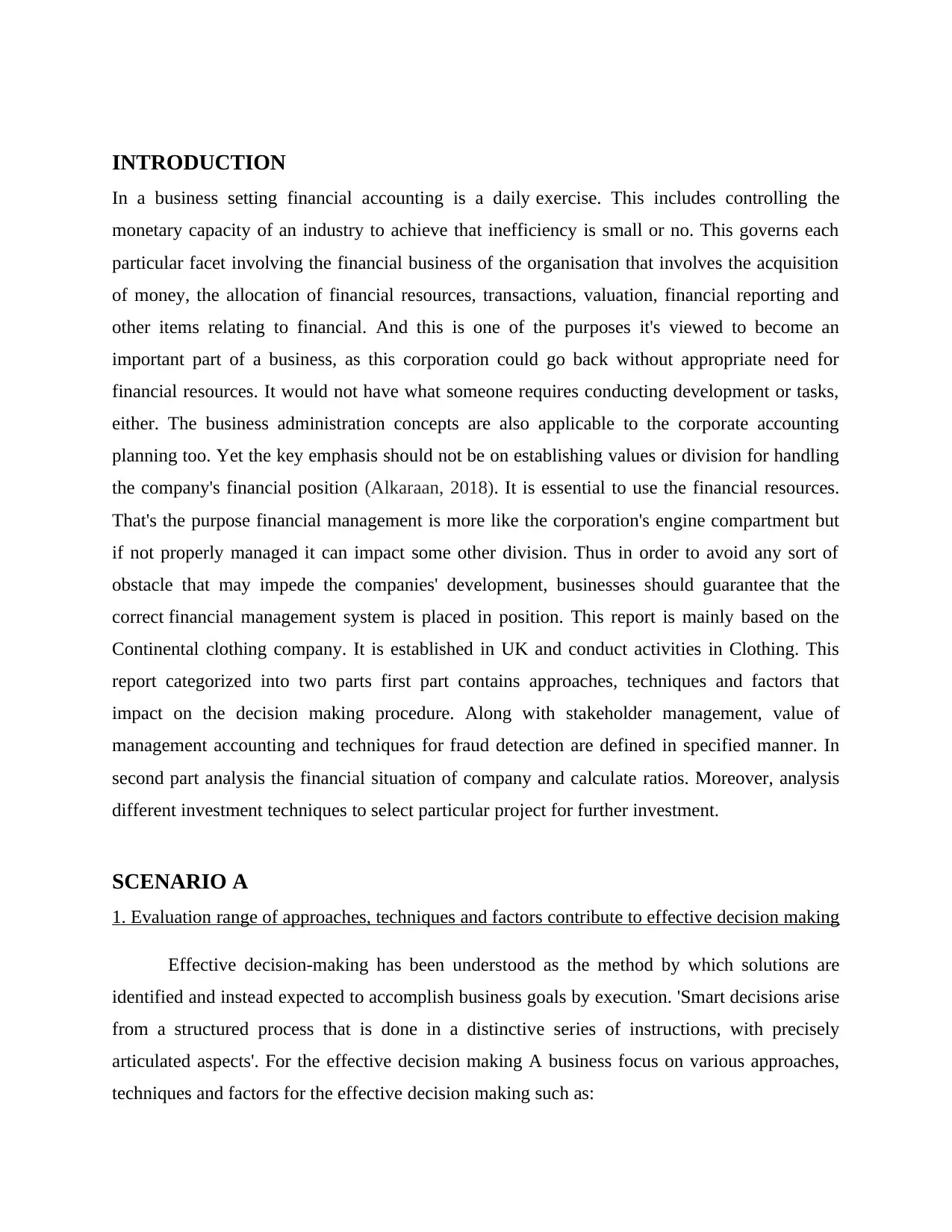
INTRODUCTION
In a business setting financial accounting is a daily exercise. This includes controlling the
monetary capacity of an industry to achieve that inefficiency is small or no. This governs each
particular facet involving the financial business of the organisation that involves the acquisition
of money, the allocation of financial resources, transactions, valuation, financial reporting and
other items relating to financial. And this is one of the purposes it's viewed to become an
important part of a business, as this corporation could go back without appropriate need for
financial resources. It would not have what someone requires conducting development or tasks,
either. The business administration concepts are also applicable to the corporate accounting
planning too. Yet the key emphasis should not be on establishing values or division for handling
the company's financial position (Alkaraan, 2018). It is essential to use the financial resources.
That's the purpose financial management is more like the corporation's engine compartment but
if not properly managed it can impact some other division. Thus in order to avoid any sort of
obstacle that may impede the companies' development, businesses should guarantee that the
correct financial management system is placed in position. This report is mainly based on the
Continental clothing company. It is established in UK and conduct activities in Clothing. This
report categorized into two parts first part contains approaches, techniques and factors that
impact on the decision making procedure. Along with stakeholder management, value of
management accounting and techniques for fraud detection are defined in specified manner. In
second part analysis the financial situation of company and calculate ratios. Moreover, analysis
different investment techniques to select particular project for further investment.
SCENARIO A
1. Evaluation range of approaches, techniques and factors contribute to effective decision making
Effective decision-making has been understood as the method by which solutions are
identified and instead expected to accomplish business goals by execution. 'Smart decisions arise
from a structured process that is done in a distinctive series of instructions, with precisely
articulated aspects'. For the effective decision making A business focus on various approaches,
techniques and factors for the effective decision making such as:
In a business setting financial accounting is a daily exercise. This includes controlling the
monetary capacity of an industry to achieve that inefficiency is small or no. This governs each
particular facet involving the financial business of the organisation that involves the acquisition
of money, the allocation of financial resources, transactions, valuation, financial reporting and
other items relating to financial. And this is one of the purposes it's viewed to become an
important part of a business, as this corporation could go back without appropriate need for
financial resources. It would not have what someone requires conducting development or tasks,
either. The business administration concepts are also applicable to the corporate accounting
planning too. Yet the key emphasis should not be on establishing values or division for handling
the company's financial position (Alkaraan, 2018). It is essential to use the financial resources.
That's the purpose financial management is more like the corporation's engine compartment but
if not properly managed it can impact some other division. Thus in order to avoid any sort of
obstacle that may impede the companies' development, businesses should guarantee that the
correct financial management system is placed in position. This report is mainly based on the
Continental clothing company. It is established in UK and conduct activities in Clothing. This
report categorized into two parts first part contains approaches, techniques and factors that
impact on the decision making procedure. Along with stakeholder management, value of
management accounting and techniques for fraud detection are defined in specified manner. In
second part analysis the financial situation of company and calculate ratios. Moreover, analysis
different investment techniques to select particular project for further investment.
SCENARIO A
1. Evaluation range of approaches, techniques and factors contribute to effective decision making
Effective decision-making has been understood as the method by which solutions are
identified and instead expected to accomplish business goals by execution. 'Smart decisions arise
from a structured process that is done in a distinctive series of instructions, with precisely
articulated aspects'. For the effective decision making A business focus on various approaches,
techniques and factors for the effective decision making such as:
Paraphrase This Document
Need a fresh take? Get an instant paraphrase of this document with our AI Paraphraser

Approaches for decision making
Knowledge based approach: This methodology requires acknowledging details as an
instrument for improving organizational performance; awareness suggests a plan for
accomplishing and optimizing organizational efficiency. For either a commercial business,
supplying a knowledge-based approach is extremely important, such that the decisions made for
systemic change also have scientific evidence. It is having a huge effect on the management
decision-making system of the firm. Such as Continental clothing business organization can use
that method to make informed decision given the information gathered (Asongu, 2017).
Formal and informal approach: This enables the decision-making process of the
organization to present a rational method. This finding the difference the reasonable decision-
making process and gives details of the methods utilized for decision-making. It tends to boost
the chances of picking systems that meet the multiple investors’ needs of the organisation. The
development of remote only with activities is limited by the availability of reasonable
optional methods. The strategy allows for quick reassessment of the conditions, desires or target
improvements of the stakeholders. It lets corporations produce more educated decisions across
all aspects.
Techniques for decision making: To make the effective decision require the use various
techniques in order to understand the situation of business. There are mentioned some techniques
that apply by the company such as:
Decision Tree: This is an important method employed to evaluate a decision. A feature
selection is an advanced computational device that helps a decision-maker to analyze and choose
the strongest possible alternatives. A decision tree is a hierarchical description of available
alternatives as well as the potential ramifications and expenses inherent between each step. The
decision-maker follows the optimal direction across the decision tree in this method. In the tree
structure a triangle represents the base, recognized as the 'decision point.' At the moment of
judgment two or more instances of opportunity proceed.
T-Chart: The graph is required to ensure possibilities vertical and horizontal. That
implies both pleasant and unpleasant factors are taken into account whenever making decisions.
Knowledge based approach: This methodology requires acknowledging details as an
instrument for improving organizational performance; awareness suggests a plan for
accomplishing and optimizing organizational efficiency. For either a commercial business,
supplying a knowledge-based approach is extremely important, such that the decisions made for
systemic change also have scientific evidence. It is having a huge effect on the management
decision-making system of the firm. Such as Continental clothing business organization can use
that method to make informed decision given the information gathered (Asongu, 2017).
Formal and informal approach: This enables the decision-making process of the
organization to present a rational method. This finding the difference the reasonable decision-
making process and gives details of the methods utilized for decision-making. It tends to boost
the chances of picking systems that meet the multiple investors’ needs of the organisation. The
development of remote only with activities is limited by the availability of reasonable
optional methods. The strategy allows for quick reassessment of the conditions, desires or target
improvements of the stakeholders. It lets corporations produce more educated decisions across
all aspects.
Techniques for decision making: To make the effective decision require the use various
techniques in order to understand the situation of business. There are mentioned some techniques
that apply by the company such as:
Decision Tree: This is an important method employed to evaluate a decision. A feature
selection is an advanced computational device that helps a decision-maker to analyze and choose
the strongest possible alternatives. A decision tree is a hierarchical description of available
alternatives as well as the potential ramifications and expenses inherent between each step. The
decision-maker follows the optimal direction across the decision tree in this method. In the tree
structure a triangle represents the base, recognized as the 'decision point.' At the moment of
judgment two or more instances of opportunity proceed.
T-Chart: The graph is required to ensure possibilities vertical and horizontal. That
implies both pleasant and unpleasant factors are taken into account whenever making decisions.
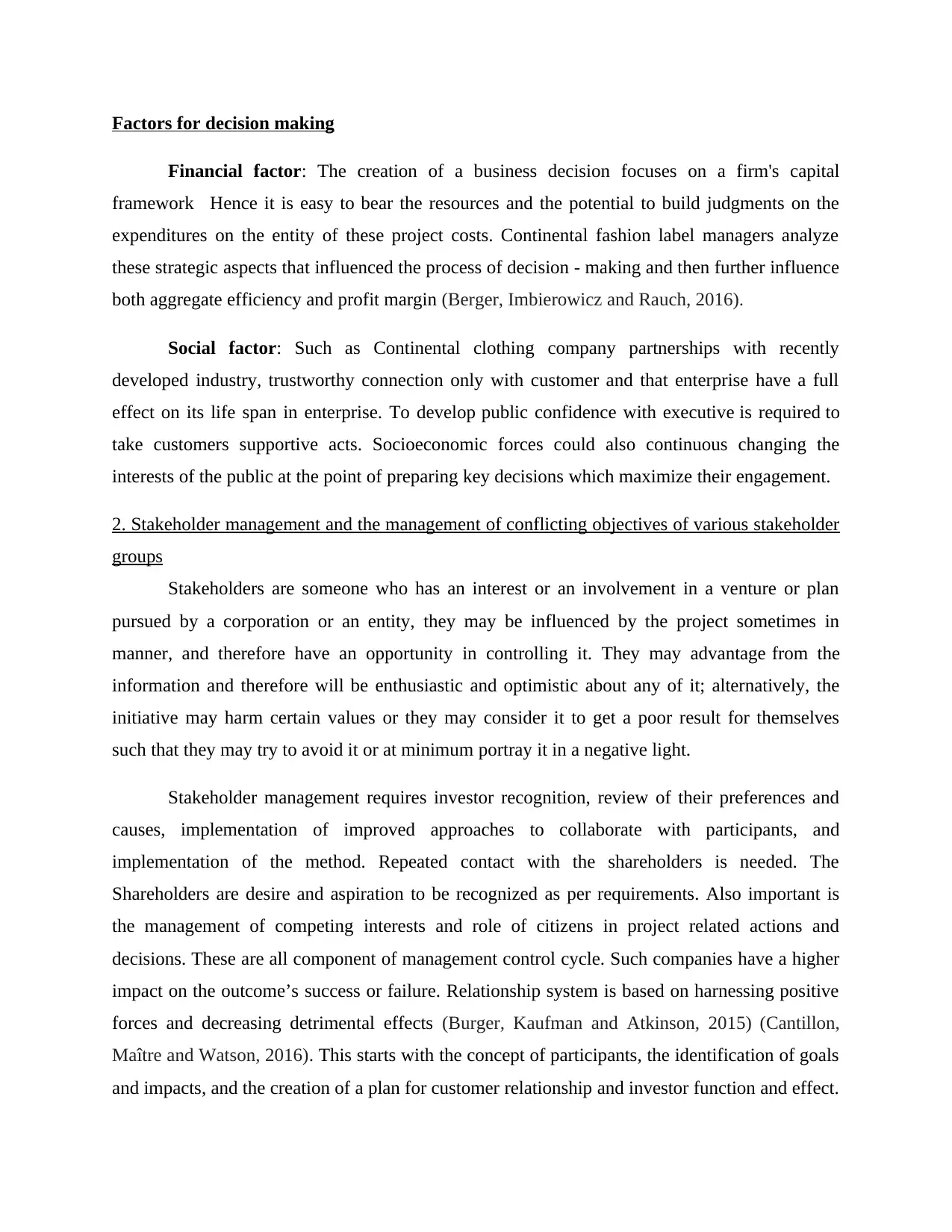
Factors for decision making
Financial factor: The creation of a business decision focuses on a firm's capital
framework Hence it is easy to bear the resources and the potential to build judgments on the
expenditures on the entity of these project costs. Continental fashion label managers analyze
these strategic aspects that influenced the process of decision - making and then further influence
both aggregate efficiency and profit margin (Berger, Imbierowicz and Rauch, 2016).
Social factor: Such as Continental clothing company partnerships with recently
developed industry, trustworthy connection only with customer and that enterprise have a full
effect on its life span in enterprise. To develop public confidence with executive is required to
take customers supportive acts. Socioeconomic forces could also continuous changing the
interests of the public at the point of preparing key decisions which maximize their engagement.
2. Stakeholder management and the management of conflicting objectives of various stakeholder
groups
Stakeholders are someone who has an interest or an involvement in a venture or plan
pursued by a corporation or an entity, they may be influenced by the project sometimes in
manner, and therefore have an opportunity in controlling it. They may advantage from the
information and therefore will be enthusiastic and optimistic about any of it; alternatively, the
initiative may harm certain values or they may consider it to get a poor result for themselves
such that they may try to avoid it or at minimum portray it in a negative light.
Stakeholder management requires investor recognition, review of their preferences and
causes, implementation of improved approaches to collaborate with participants, and
implementation of the method. Repeated contact with the shareholders is needed. The
Shareholders are desire and aspiration to be recognized as per requirements. Also important is
the management of competing interests and role of citizens in project related actions and
decisions. These are all component of management control cycle. Such companies have a higher
impact on the outcome’s success or failure. Relationship system is based on harnessing positive
forces and decreasing detrimental effects (Burger, Kaufman and Atkinson, 2015) (Cantillon,
Maître and Watson, 2016). This starts with the concept of participants, the identification of goals
and impacts, and the creation of a plan for customer relationship and investor function and effect.
Financial factor: The creation of a business decision focuses on a firm's capital
framework Hence it is easy to bear the resources and the potential to build judgments on the
expenditures on the entity of these project costs. Continental fashion label managers analyze
these strategic aspects that influenced the process of decision - making and then further influence
both aggregate efficiency and profit margin (Berger, Imbierowicz and Rauch, 2016).
Social factor: Such as Continental clothing company partnerships with recently
developed industry, trustworthy connection only with customer and that enterprise have a full
effect on its life span in enterprise. To develop public confidence with executive is required to
take customers supportive acts. Socioeconomic forces could also continuous changing the
interests of the public at the point of preparing key decisions which maximize their engagement.
2. Stakeholder management and the management of conflicting objectives of various stakeholder
groups
Stakeholders are someone who has an interest or an involvement in a venture or plan
pursued by a corporation or an entity, they may be influenced by the project sometimes in
manner, and therefore have an opportunity in controlling it. They may advantage from the
information and therefore will be enthusiastic and optimistic about any of it; alternatively, the
initiative may harm certain values or they may consider it to get a poor result for themselves
such that they may try to avoid it or at minimum portray it in a negative light.
Stakeholder management requires investor recognition, review of their preferences and
causes, implementation of improved approaches to collaborate with participants, and
implementation of the method. Repeated contact with the shareholders is needed. The
Shareholders are desire and aspiration to be recognized as per requirements. Also important is
the management of competing interests and role of citizens in project related actions and
decisions. These are all component of management control cycle. Such companies have a higher
impact on the outcome’s success or failure. Relationship system is based on harnessing positive
forces and decreasing detrimental effects (Burger, Kaufman and Atkinson, 2015) (Cantillon,
Maître and Watson, 2016). This starts with the concept of participants, the identification of goals
and impacts, and the creation of a plan for customer relationship and investor function and effect.
⊘ This is a preview!⊘
Do you want full access?
Subscribe today to unlock all pages.

Trusted by 1+ million students worldwide
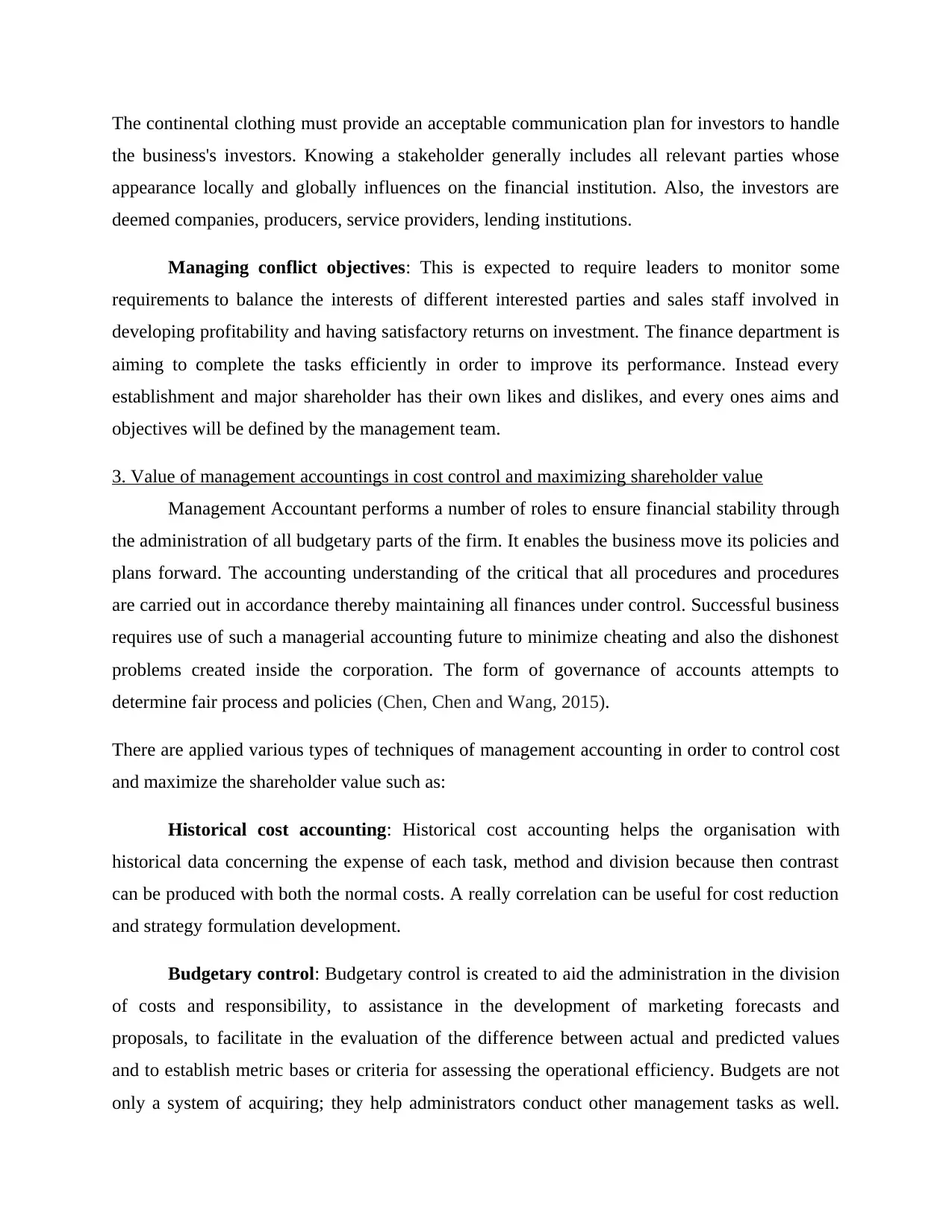
The continental clothing must provide an acceptable communication plan for investors to handle
the business's investors. Knowing a stakeholder generally includes all relevant parties whose
appearance locally and globally influences on the financial institution. Also, the investors are
deemed companies, producers, service providers, lending institutions.
Managing conflict objectives: This is expected to require leaders to monitor some
requirements to balance the interests of different interested parties and sales staff involved in
developing profitability and having satisfactory returns on investment. The finance department is
aiming to complete the tasks efficiently in order to improve its performance. Instead every
establishment and major shareholder has their own likes and dislikes, and every ones aims and
objectives will be defined by the management team.
3. Value of management accountings in cost control and maximizing shareholder value
Management Accountant performs a number of roles to ensure financial stability through
the administration of all budgetary parts of the firm. It enables the business move its policies and
plans forward. The accounting understanding of the critical that all procedures and procedures
are carried out in accordance thereby maintaining all finances under control. Successful business
requires use of such a managerial accounting future to minimize cheating and also the dishonest
problems created inside the corporation. The form of governance of accounts attempts to
determine fair process and policies (Chen, Chen and Wang, 2015).
There are applied various types of techniques of management accounting in order to control cost
and maximize the shareholder value such as:
Historical cost accounting: Historical cost accounting helps the organisation with
historical data concerning the expense of each task, method and division because then contrast
can be produced with both the normal costs. A really correlation can be useful for cost reduction
and strategy formulation development.
Budgetary control: Budgetary control is created to aid the administration in the division
of costs and responsibility, to assistance in the development of marketing forecasts and
proposals, to facilitate in the evaluation of the difference between actual and predicted values
and to establish metric bases or criteria for assessing the operational efficiency. Budgets are not
only a system of acquiring; they help administrators conduct other management tasks as well.
the business's investors. Knowing a stakeholder generally includes all relevant parties whose
appearance locally and globally influences on the financial institution. Also, the investors are
deemed companies, producers, service providers, lending institutions.
Managing conflict objectives: This is expected to require leaders to monitor some
requirements to balance the interests of different interested parties and sales staff involved in
developing profitability and having satisfactory returns on investment. The finance department is
aiming to complete the tasks efficiently in order to improve its performance. Instead every
establishment and major shareholder has their own likes and dislikes, and every ones aims and
objectives will be defined by the management team.
3. Value of management accountings in cost control and maximizing shareholder value
Management Accountant performs a number of roles to ensure financial stability through
the administration of all budgetary parts of the firm. It enables the business move its policies and
plans forward. The accounting understanding of the critical that all procedures and procedures
are carried out in accordance thereby maintaining all finances under control. Successful business
requires use of such a managerial accounting future to minimize cheating and also the dishonest
problems created inside the corporation. The form of governance of accounts attempts to
determine fair process and policies (Chen, Chen and Wang, 2015).
There are applied various types of techniques of management accounting in order to control cost
and maximize the shareholder value such as:
Historical cost accounting: Historical cost accounting helps the organisation with
historical data concerning the expense of each task, method and division because then contrast
can be produced with both the normal costs. A really correlation can be useful for cost reduction
and strategy formulation development.
Budgetary control: Budgetary control is created to aid the administration in the division
of costs and responsibility, to assistance in the development of marketing forecasts and
proposals, to facilitate in the evaluation of the difference between actual and predicted values
and to establish metric bases or criteria for assessing the operational efficiency. Budgets are not
only a system of acquiring; they help administrators conduct other management tasks as well.
Paraphrase This Document
Need a fresh take? Get an instant paraphrase of this document with our AI Paraphraser

Financial planning is strongly related to the preparation, coordination and management of
programs. It also helps to identify variations from expected performance. If the supervisor
records these anomalies he will track things in the company in future.
Standard costing: Standard costing is setting the costing system even in the most
effective operating environment, contrasting the real only with model, estimating and evaluating
the difference, in order to ascertain the causes and define the fault and suggest corrective
measures because then negative outcomes do not occur elsewhere. In order to have price
transparency this component is appropriate (Danoshana and Ravivathani, 2019).
Funds flow statement: To order to evaluate the improvements to the monetary condition
of a corporate entity within two days, the administration accounting utilizes the fund flow
analysis methodology. This tells you where the funds come through and how they are utilized in
the company. It definitely helps with economic monitoring and control, direction for the
potential and quantitative research.
4. Techniques for fraud detection and prevention approach for ethical decision making
The technology of fraud detection has made major progress from developments in
processing frequencies (high-performance analytics), machine learning, and other aspects of
artificial intelligence (AI). Fraud affects every aspect of our lives; it raises the value pay for stuff,
it gives away tax revenue, it drains technological capital and sometimes even damages people's
lives. The technologies chosen for fraud detection and prevention must be able to take advantage
from multiple data structures. Reference value systems will be used to help handle false alarms
and track socialization to provide a holistic view of the scammers and offenders' operation. The
application of machine learning models – including such feed forward belief knowledge bases,
severe linear regression, and machine (svm and also validated models such as regression models,
self-organizing maps, decision trees, and quartets – has proved much more effective and precise
that rules-based methods.
Many methodologies are often used to detect or avoid the fraud. Build a portfolio of
potential fraud that also involves vulnerability assessment, identifying the areas where cheating
is likely to take place in the enterprise, and the potential types of fraud within the sites (Fan,
2015). Then consider the severity, often dependent on the company's debt transparency. Focused
programs. It also helps to identify variations from expected performance. If the supervisor
records these anomalies he will track things in the company in future.
Standard costing: Standard costing is setting the costing system even in the most
effective operating environment, contrasting the real only with model, estimating and evaluating
the difference, in order to ascertain the causes and define the fault and suggest corrective
measures because then negative outcomes do not occur elsewhere. In order to have price
transparency this component is appropriate (Danoshana and Ravivathani, 2019).
Funds flow statement: To order to evaluate the improvements to the monetary condition
of a corporate entity within two days, the administration accounting utilizes the fund flow
analysis methodology. This tells you where the funds come through and how they are utilized in
the company. It definitely helps with economic monitoring and control, direction for the
potential and quantitative research.
4. Techniques for fraud detection and prevention approach for ethical decision making
The technology of fraud detection has made major progress from developments in
processing frequencies (high-performance analytics), machine learning, and other aspects of
artificial intelligence (AI). Fraud affects every aspect of our lives; it raises the value pay for stuff,
it gives away tax revenue, it drains technological capital and sometimes even damages people's
lives. The technologies chosen for fraud detection and prevention must be able to take advantage
from multiple data structures. Reference value systems will be used to help handle false alarms
and track socialization to provide a holistic view of the scammers and offenders' operation. The
application of machine learning models – including such feed forward belief knowledge bases,
severe linear regression, and machine (svm and also validated models such as regression models,
self-organizing maps, decision trees, and quartets – has proved much more effective and precise
that rules-based methods.
Many methodologies are often used to detect or avoid the fraud. Build a portfolio of
potential fraud that also involves vulnerability assessment, identifying the areas where cheating
is likely to take place in the enterprise, and the potential types of fraud within the sites (Fan,
2015). Then consider the severity, often dependent on the company's debt transparency. Focused
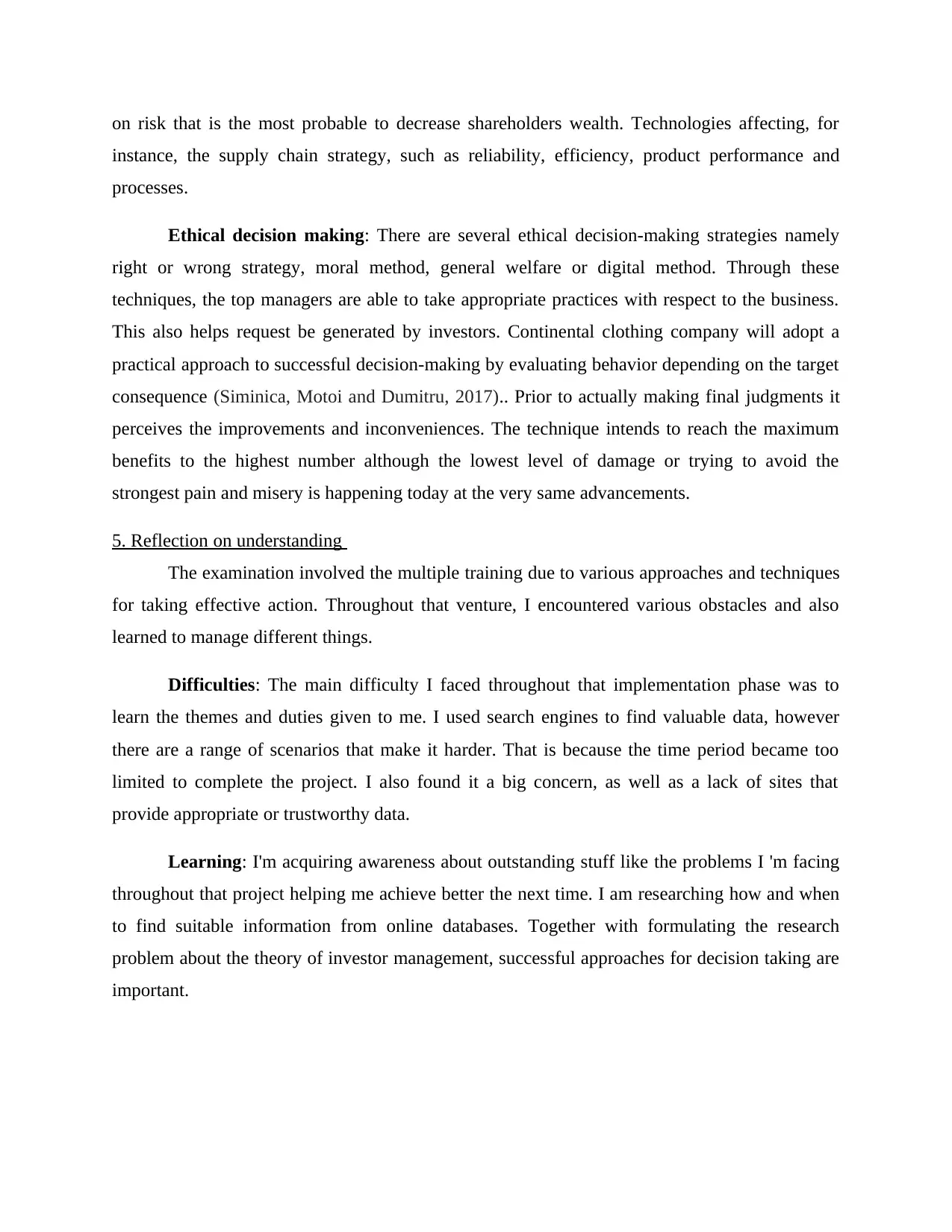
on risk that is the most probable to decrease shareholders wealth. Technologies affecting, for
instance, the supply chain strategy, such as reliability, efficiency, product performance and
processes.
Ethical decision making: There are several ethical decision-making strategies namely
right or wrong strategy, moral method, general welfare or digital method. Through these
techniques, the top managers are able to take appropriate practices with respect to the business.
This also helps request be generated by investors. Continental clothing company will adopt a
practical approach to successful decision-making by evaluating behavior depending on the target
consequence (Siminica, Motoi and Dumitru, 2017).. Prior to actually making final judgments it
perceives the improvements and inconveniences. The technique intends to reach the maximum
benefits to the highest number although the lowest level of damage or trying to avoid the
strongest pain and misery is happening today at the very same advancements.
5. Reflection on understanding
The examination involved the multiple training due to various approaches and techniques
for taking effective action. Throughout that venture, I encountered various obstacles and also
learned to manage different things.
Difficulties: The main difficulty I faced throughout that implementation phase was to
learn the themes and duties given to me. I used search engines to find valuable data, however
there are a range of scenarios that make it harder. That is because the time period became too
limited to complete the project. I also found it a big concern, as well as a lack of sites that
provide appropriate or trustworthy data.
Learning: I'm acquiring awareness about outstanding stuff like the problems I 'm facing
throughout that project helping me achieve better the next time. I am researching how and when
to find suitable information from online databases. Together with formulating the research
problem about the theory of investor management, successful approaches for decision taking are
important.
instance, the supply chain strategy, such as reliability, efficiency, product performance and
processes.
Ethical decision making: There are several ethical decision-making strategies namely
right or wrong strategy, moral method, general welfare or digital method. Through these
techniques, the top managers are able to take appropriate practices with respect to the business.
This also helps request be generated by investors. Continental clothing company will adopt a
practical approach to successful decision-making by evaluating behavior depending on the target
consequence (Siminica, Motoi and Dumitru, 2017).. Prior to actually making final judgments it
perceives the improvements and inconveniences. The technique intends to reach the maximum
benefits to the highest number although the lowest level of damage or trying to avoid the
strongest pain and misery is happening today at the very same advancements.
5. Reflection on understanding
The examination involved the multiple training due to various approaches and techniques
for taking effective action. Throughout that venture, I encountered various obstacles and also
learned to manage different things.
Difficulties: The main difficulty I faced throughout that implementation phase was to
learn the themes and duties given to me. I used search engines to find valuable data, however
there are a range of scenarios that make it harder. That is because the time period became too
limited to complete the project. I also found it a big concern, as well as a lack of sites that
provide appropriate or trustworthy data.
Learning: I'm acquiring awareness about outstanding stuff like the problems I 'm facing
throughout that project helping me achieve better the next time. I am researching how and when
to find suitable information from online databases. Together with formulating the research
problem about the theory of investor management, successful approaches for decision taking are
important.
⊘ This is a preview!⊘
Do you want full access?
Subscribe today to unlock all pages.

Trusted by 1+ million students worldwide

Scenario B
1. Evaluate how data obtained might help to inform operational or strategies decisions for the
organization
It has proposed managers tend to work across their everyday routines. Management
teams would also have all of the existing price level knowledge mostly on industry. That's not as
convenient as every other the most pay-effective or efficient practitioners. Information sharing is
also a major process which can have a huge effect on business over a specific period of period.
The managers obtain a lot of routine technical experience (Fich, Nguyen and Officer, 2018).
Everything decision-making relevant is centered on the aspect and role of the company. This
allows the memories and insights of the management teams as well as others who guide their
daily decision-making needs. It is critical that Continental's financial results be applied to
determine its actual position. The following is the evaluation of the corporation ratio utilizing
information from the annual statements of the organization which might direct the tactical and
organizational judgements of the continental clothing retailer:
Ratio analysis: It is generally seen as an efficient objective for reviewing the relative
findings. Based on the financial statements, the based on assessment a statistical or correlative
connection between two facts and data to analyze the functionality and weaknesses of the
company, its cash conditions and current efficiency. That lets other shareholders evaluate various
parts of a company's results. Continental clothing company and its assessment encourage the
earnings and organizational important decisions of a business in this respect. Following table are
some of the resources obtained:
Net profit margin:
2018 (£’ Million) 2019 (£’ Million)
Net Profit 2897 -1225
Revenues 44404 44478
Net Profit Margin (%) 6.52 % -2.75 %
1. Evaluate how data obtained might help to inform operational or strategies decisions for the
organization
It has proposed managers tend to work across their everyday routines. Management
teams would also have all of the existing price level knowledge mostly on industry. That's not as
convenient as every other the most pay-effective or efficient practitioners. Information sharing is
also a major process which can have a huge effect on business over a specific period of period.
The managers obtain a lot of routine technical experience (Fich, Nguyen and Officer, 2018).
Everything decision-making relevant is centered on the aspect and role of the company. This
allows the memories and insights of the management teams as well as others who guide their
daily decision-making needs. It is critical that Continental's financial results be applied to
determine its actual position. The following is the evaluation of the corporation ratio utilizing
information from the annual statements of the organization which might direct the tactical and
organizational judgements of the continental clothing retailer:
Ratio analysis: It is generally seen as an efficient objective for reviewing the relative
findings. Based on the financial statements, the based on assessment a statistical or correlative
connection between two facts and data to analyze the functionality and weaknesses of the
company, its cash conditions and current efficiency. That lets other shareholders evaluate various
parts of a company's results. Continental clothing company and its assessment encourage the
earnings and organizational important decisions of a business in this respect. Following table are
some of the resources obtained:
Net profit margin:
2018 (£’ Million) 2019 (£’ Million)
Net Profit 2897 -1225
Revenues 44404 44478
Net Profit Margin (%) 6.52 % -2.75 %
Paraphrase This Document
Need a fresh take? Get an instant paraphrase of this document with our AI Paraphraser
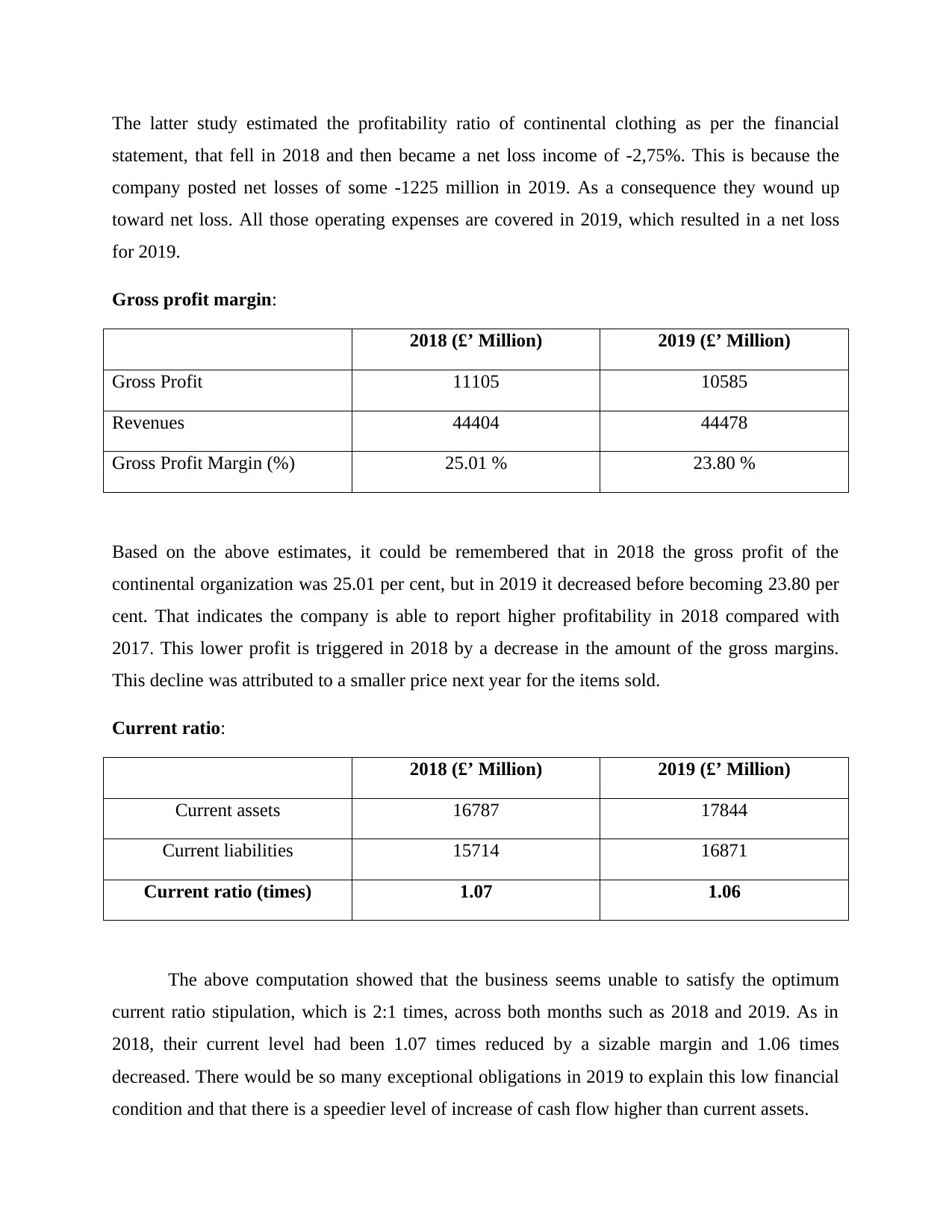
The latter study estimated the profitability ratio of continental clothing as per the financial
statement, that fell in 2018 and then became a net loss income of -2,75%. This is because the
company posted net losses of some -1225 million in 2019. As a consequence they wound up
toward net loss. All those operating expenses are covered in 2019, which resulted in a net loss
for 2019.
Gross profit margin:
2018 (£’ Million) 2019 (£’ Million)
Gross Profit 11105 10585
Revenues 44404 44478
Gross Profit Margin (%) 25.01 % 23.80 %
Based on the above estimates, it could be remembered that in 2018 the gross profit of the
continental organization was 25.01 per cent, but in 2019 it decreased before becoming 23.80 per
cent. That indicates the company is able to report higher profitability in 2018 compared with
2017. This lower profit is triggered in 2018 by a decrease in the amount of the gross margins.
This decline was attributed to a smaller price next year for the items sold.
Current ratio:
2018 (£’ Million) 2019 (£’ Million)
Current assets 16787 17844
Current liabilities 15714 16871
Current ratio (times) 1.07 1.06
The above computation showed that the business seems unable to satisfy the optimum
current ratio stipulation, which is 2:1 times, across both months such as 2018 and 2019. As in
2018, their current level had been 1.07 times reduced by a sizable margin and 1.06 times
decreased. There would be so many exceptional obligations in 2019 to explain this low financial
condition and that there is a speedier level of increase of cash flow higher than current assets.
statement, that fell in 2018 and then became a net loss income of -2,75%. This is because the
company posted net losses of some -1225 million in 2019. As a consequence they wound up
toward net loss. All those operating expenses are covered in 2019, which resulted in a net loss
for 2019.
Gross profit margin:
2018 (£’ Million) 2019 (£’ Million)
Gross Profit 11105 10585
Revenues 44404 44478
Gross Profit Margin (%) 25.01 % 23.80 %
Based on the above estimates, it could be remembered that in 2018 the gross profit of the
continental organization was 25.01 per cent, but in 2019 it decreased before becoming 23.80 per
cent. That indicates the company is able to report higher profitability in 2018 compared with
2017. This lower profit is triggered in 2018 by a decrease in the amount of the gross margins.
This decline was attributed to a smaller price next year for the items sold.
Current ratio:
2018 (£’ Million) 2019 (£’ Million)
Current assets 16787 17844
Current liabilities 15714 16871
Current ratio (times) 1.07 1.06
The above computation showed that the business seems unable to satisfy the optimum
current ratio stipulation, which is 2:1 times, across both months such as 2018 and 2019. As in
2018, their current level had been 1.07 times reduced by a sizable margin and 1.06 times
decreased. There would be so many exceptional obligations in 2019 to explain this low financial
condition and that there is a speedier level of increase of cash flow higher than current assets.
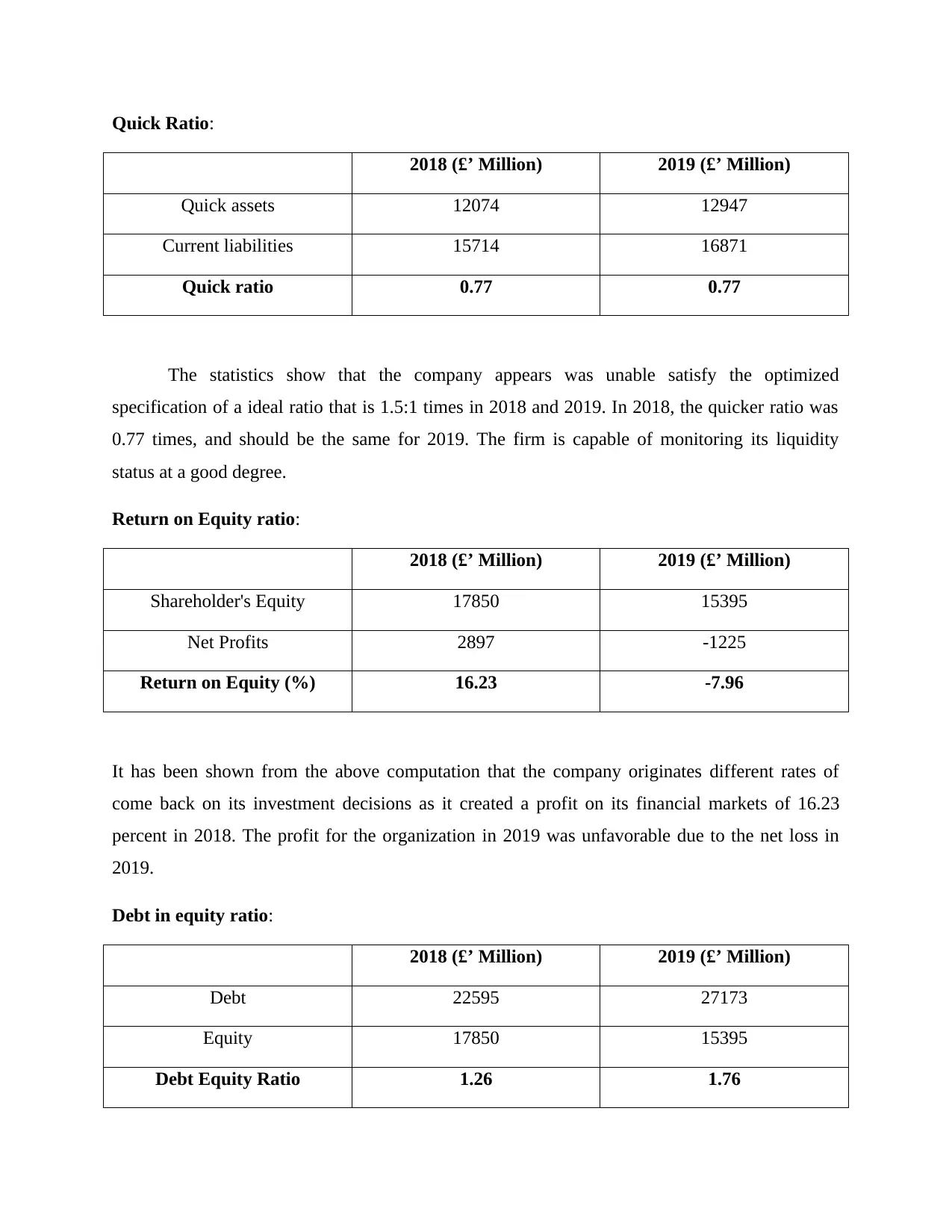
Quick Ratio:
2018 (£’ Million) 2019 (£’ Million)
Quick assets 12074 12947
Current liabilities 15714 16871
Quick ratio 0.77 0.77
The statistics show that the company appears was unable satisfy the optimized
specification of a ideal ratio that is 1.5:1 times in 2018 and 2019. In 2018, the quicker ratio was
0.77 times, and should be the same for 2019. The firm is capable of monitoring its liquidity
status at a good degree.
Return on Equity ratio:
2018 (£’ Million) 2019 (£’ Million)
Shareholder's Equity 17850 15395
Net Profits 2897 -1225
Return on Equity (%) 16.23 -7.96
It has been shown from the above computation that the company originates different rates of
come back on its investment decisions as it created a profit on its financial markets of 16.23
percent in 2018. The profit for the organization in 2019 was unfavorable due to the net loss in
2019.
Debt in equity ratio:
2018 (£’ Million) 2019 (£’ Million)
Debt 22595 27173
Equity 17850 15395
Debt Equity Ratio 1.26 1.76
2018 (£’ Million) 2019 (£’ Million)
Quick assets 12074 12947
Current liabilities 15714 16871
Quick ratio 0.77 0.77
The statistics show that the company appears was unable satisfy the optimized
specification of a ideal ratio that is 1.5:1 times in 2018 and 2019. In 2018, the quicker ratio was
0.77 times, and should be the same for 2019. The firm is capable of monitoring its liquidity
status at a good degree.
Return on Equity ratio:
2018 (£’ Million) 2019 (£’ Million)
Shareholder's Equity 17850 15395
Net Profits 2897 -1225
Return on Equity (%) 16.23 -7.96
It has been shown from the above computation that the company originates different rates of
come back on its investment decisions as it created a profit on its financial markets of 16.23
percent in 2018. The profit for the organization in 2019 was unfavorable due to the net loss in
2019.
Debt in equity ratio:
2018 (£’ Million) 2019 (£’ Million)
Debt 22595 27173
Equity 17850 15395
Debt Equity Ratio 1.26 1.76
⊘ This is a preview!⊘
Do you want full access?
Subscribe today to unlock all pages.

Trusted by 1+ million students worldwide
1 out of 21
Related Documents
Your All-in-One AI-Powered Toolkit for Academic Success.
+13062052269
info@desklib.com
Available 24*7 on WhatsApp / Email
![[object Object]](/_next/static/media/star-bottom.7253800d.svg)
Unlock your academic potential
Copyright © 2020–2025 A2Z Services. All Rights Reserved. Developed and managed by ZUCOL.





